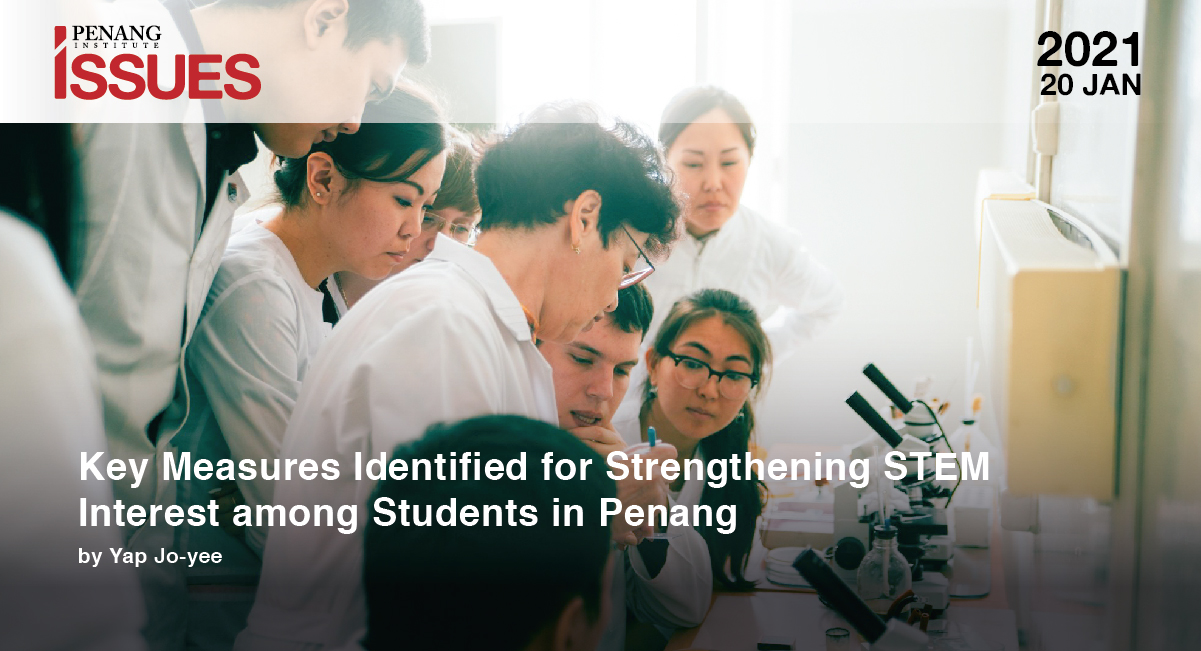Executive Summary[1]
- This article considers factors behind STEM uptake in Penang, based on a state-wide survey conducted amongst Penang’s secondary and tertiary students and educators by Penang Institute, and proposes key measures to turn the tide
- The state is recommended to incentivise development of Penang’s life sciences industry. Students show strong interest in life sciences (40% of science students), but there are limited relevant education pathways and career choices in Penang for them. Academic and career aspirations are major factors of STEM uptake.
- Educators need to encourage positive parental attitudes towards STEM by including them in STEM initiatives. After stripping out the role of parent’s education and occupation type (STEM or non-STEM), students are about three times more likely to choose STEM pathways if their parents show active support for them.
- Education agencies and schools need to empower teachers with digital tools and skills. Effective and inspiring science teaching significantly increases the likelihood of STEM uptake, but time and resource constraints are barriers. These can be partly mitigated with greater digitalisation in the classroom.
- Schools and STEM industrialists should cooperate to actively disseminate STEM education and career information before upper-secondary stream choices are made, and highlight female STEM role models. Higher STEM information level significantly increases the likelihood of pursuing STEM. Moreover, interventions must be early because students persist with their tertiary fields of study.
- Career assistance centres can help STEM graduates negotiate for higher salaries by supporting job applications and soft skill development. This partially addresses the issue of low renumeration, one of the reasons deterring graduates from STEM careers.
Introduction
Penang’s economy is partly driven by its growing high-tech and mid-tech manufacturing industries. Any expansion of this sector naturally requires an expansion in its access to STEM (science, technology, engineering and mathematics) talent. In 2019 alone, investment in this sector was expected to create almost 19,000 jobs[2]. Unfortunately, demand has not been met by supply. Industries such as high-tech manufacturing, precision engineering and automation, medical devices and life sciences have long experienced difficulty filling vacancies and retaining high-skilled workers.
The share of STEM graduates in Penang’s public universities has actually dropped by 9.5 percentage points within a decade. By 2017, only 41.2% of graduates held STEM degrees[3], still far from the government’s goal of 60%. This skills shortage has already begun to restrict firms’ efforts to innovate and expand[4]. In short, the push for STEM education grows from a serious concern for Penang’s economic development and its innovative capacity.
In Penang’s public secondary schools, as much as 85% of science students and almost 50% of non-science students are in fact interested in science[5]. If one considers that this positive interest exists alongside a clear need by corporations for STEM workers in Penang, why then is the proportion of STEM graduates falling, instead of rising? This article summarises factors behind STEM uptake in Penang, based on a state-wide survey conducted by Penang Institute amongst Penang’s secondary and tertiary students and educators, and proposes key measures to turn the tide[5].
STEM Uptake Factors
Survey results show that key determinants of STEM uptake are parental attitudes and peer influence, academic and career goals, and some school-related factors. These affect interest and perception of STEM, as well as self-efficacy.
Parental attitudes and peer influence
Parents and friends play a critical role in the choices that students make for their education and future career. Students are more likely to choose STEM pathways if their parents hold STEM occupations. Nonetheless, even without a parent in STEM, students are still about three times more likely to select STEM studies if their parents actively encourage them to. When parents do not guide their children’s choices, students tend to choose non-STEM routes.
This suggests that parental involvement in children’s education, and a positive attitude towards STEM are crucial for increasing STEM uptake. Parental occupation is a factor, partly because parents who hold STEM occupations are more prone to engaging their children in conversations about STEM education and careers, and are better placed to give them accurate information about those pathways. The amount of information students have about STEM pathways shapes their decision-making process, their perceptions of likelihood to succeed in a STEM career[6], and their intentions to pursue it[7]. Regression results of this study confirm that the level of information students have is a significant factor affecting STEM uptake.
A scrutiny of family factors also highlights the influence that mothers have in their children’s decisions. Students are more likely to choose non-STEM courses if their mothers have pursued tertiary education (fathers have no effect). Most educated mothers hold non-STEM degrees, however, and it is likely that those of them who grasp the importance of education encourage their children to pursue tertiary degrees, but simply in courses similar to theirs. This implies the importance of encouraging female participation in STEM now, because the role of mothers is significant to future STEM uptakes.
Peers are particularly influential among upper-secondary students, but not among tertiary students. Secondary students are 1.7 times more likely to select the science stream if their peers do so too.
Academic and career goals
Secondary students already interested in science choose STEM pathways mainly out of preference for the field. However, a sizeable portion are motivated by academic and career aspirations. About 22% choose to pursue a STEM education mainly because it expands their future study choices, and 18.3% believe it will get them a good job. Students from high-performing schools especially emphasise these factors.
While rare, there are secondary students who pursue the science stream despite being disinterested in STEM (3.5% of science students). They do so primarily because they believe it expands their choices when it comes to choosing tertiary degrees (52.4% of responses), and is likely to guarantee a good job (28.6%). Nearly 94% of tertiary STEM students with no liking for science who choose STEM education do so for the sake of job opportunities in the field.
Low pay in STEM careers, and a lack of job opportunities are a deterrent for many students. This is unsurprising, given that there is a significant mismatch in Penang between students’ areas of interests and corresponding pathways.
Survey results show that 40% of secondary science students are interested in biotechnology and biomedicine, 29.4% are interested in medicine, and 17.2% in pharmacy. However, there are few channels that students can take after secondary school. The life sciences industry in Penang is also not as developed as that in other states or countries. This lack of a clear pathway for those interested in the field may be one reason for the low post-secondary uptake of STEM in Penang, through an outflow of talent to other fields or locations. Besides that, girls are more interested in health issues (55.3%) compared to only 30% of boys; this may also be a potential contributor to the gender divide in STEM.
A clear discrepancy in study interests exists between secondary science and non-science students. Interestingly, non-science students considering STEM tertiary courses (one-fifth of all non-science students) are more interested in less conventional fields that are not being considered by science students. Of the one-fifth contemplating STEM courses, 41.7% are interested in maths and statistics, 31.9% in astronomy, 25% in computer science, 16.7% in research and product development, 12.5% in machine learning, and 12.5% in information technology.
It should be noted that at the tertiary level, more than 75% of students in general plan to stick to their field of study. Thus, efforts to boost STEM uptake need to happen early in education, preferably before upper-secondary level.
School-related factors
Seventy-four percent of secondary students agree that the school plays a part in motivating them to pursue STEM. This is chiefly through the effect that teachers’ pedagogical strategies have on them. Satisfaction with science classes are a positive predictor of science interest level.
Secondary students feel most motivated to learn science when their teachers:
a) use real-life examples;
b) assist them in learning science concepts;
c) encourage participation in learning science;
d) are enthusiastic and inspiring; and
e) identify challenges that individual students face when learning science concepts.
In view of huge efforts and resources going into organising STEM activities within school and without, it is somewhat surprising that secondary students do not feel that they have a supportive science environment (well-equipped laboratories, science clubs) or that science events are as important as the teacher-related factors mentioned above. This does not mean that STEM activities are not valued. About two-thirds of students wish to see more of them as a way of fostering science interest.
Nonetheless, the emphasis placed on teaching methods is consistent with the main reasons secondary students give for being disinterested in science. More than half of these students dislike science because “the subject is difficult” and “I don’t understand the subject”. More than 80% of all secondary students think that science should be made more interesting and fun. Fifty-six percent want to see more interactive and hands-on lessons.
Amongst tertiary students, only 37% are satisfied with their science classes. Students are dissatisfied because teachers do not update them with the latest developments in science and technology, and teaching methods are too wooden and exam-oriented.
The evidence strongly suggests that teachers’ attitudes and their classroom performance significantly influence students’ perception of STEM, the level of STEM information they have, and thus, STEM uptake. Teachers should not only transmit knowledge, but impart enthusiasm by first being knowledgeable and enthusiastic about STEM subjects. However, teachers also face challenges in carrying out their duties as educators. Box 1 elaborates these challenges further.
Exam results are also an important determinant. Malaysian national schools typically sort students into the science and non-science stream largely based on their results. For example, 36.3% of non-science secondary students and 35.6% of tertiary students interested in science claim that they had no other option but to pick non-STEM pathways because they had not met the requirements for STEM ones.
Even amongst high-performing science students, results remain a factor for leaving the field after secondary school. It is likely that self-efficacy, students’ confidence in their own abilities, and relative STEM scores, STEM subject scores compared to non-STEM subject scores, are underlying reasons.
Conclusion and Proposed Measures
One conclusion of this research is that having an interest in science is an important, but not the determining factor in STEM uptake. Were this the case, the high percentage of students interested in science would suggest that there is no cause for concern. Students also pursue STEM pathways based on the encouragement of their families, the schooling environment, their knowledge of STEM careers, future career prospects, and their confidence in succeeding in the field.
Many constraints, such as those related to teacher quality, curriculum, assessment, and school funding, require system-wide reforms by the Ministry of Education[8]. Nonetheless, there are key measures required by state agencies and non-state actors to address the ebb of STEM students in Penang. These are as proposed below:
1. Incentivise the development of Penang’s life sciences industry
To retain and attract STEM graduates to Penang, the state must persistently develop its life sciences industry. A concerted effort should be made to attract investors into the industry and to enhance research and development capabilities within this field. For example, special incentives from the state government, in the form of subsidies, tax breaks or recognition, can be given for innovations that arise from partnerships between academia and industry players.
2. Empower teachers through effective teaching tools and digital skills
At the state level, actors such as the Penang Education Council and Penang Science Cluster can develop and run short courses for teachers to equip them with effective teaching tools and digital skills. Courses should be tailored to meet teachers at their existing skill level, showcase success stories, and include a short period of mentorship to ensure adoption of methods and tools. Assistance to help teachers leverage on technology, and automate administrative tasks would also ease the time constraints that teachers face.
3. Disseminate STEM information through schools
Schools are crucial channels through which students obtain STEM information. Suggested ways to improve the information students receive are:
a) Run mandatory career courses before students select their subjects at upper secondary level;
b) Invite recruitment consultants and experienced industrialists to explain the current job market to secondary students and teachers on an annual basis;
c) Involve secondary students of all ages in short industry-related projects as part of CSR initiatives; and
d) Make available short apprenticeships or one-week insight programmes for secondary students as a way of recruiting future talent.
4. Build positive parental attitudes towards STEM
Given how important a role parents play in the study and career decisions of their children, schools and actors such as Penang STEM, Penggerak Komuniti Muda (PEKA), and Penang Science Cluster (PSC) need to proactively involve parents in STEM events where possible, to foster positive parental attitudes towards STEM occupations. These events should seek to inform parents of entry requirements for STEM education, career pathways, and benefits.
5. Encourage female participation in STEM
By highlighting female STEM role models through workshops, interactive activities, competitions and exhibitions, from primary up till tertiary level, educators help dissolve the idea of STEM occupations being associated only with men. Industry players can contribute by launching female-only apprenticeships or internships where participants are exposed to female industrialists in STEM.
6. Provide career support to graduates
Low renumeration is one of the largest hindrances to higher STEM uptake. To attract talent, firms should create competitive pay packages. At the same time, the Penang Career Assistance and Talent (CAT) Centre and university career centres can help graduates communicate their skills and strengths to employers as a way of negotiating for higher salaries, by supporting them with mock interviews, CV reviews, and career workshops.
Editor: Ooi Kee Beng
Editorial Team: Sheryl Teoh, Tan Lii Inn, Alexander Fernandez, and Nur Fitriah (Designer)
[1] This is a summary of a larger project entitled Students’ Choice of STEM Study in Secondary and Tertiary Education in Penang. The team members of the project include Ong Wooi Leng, Dr Negin Vaghefi and Ng Kar Yong, all from Penang Institute’s Socio-Economics and Statistics Programme.
[2] Penang Institute (2020). Penang Economic and Development Report 2019/2020. Accessed at https://penanginstitute.org/publications/books-and-reports/penang-economic-and-development-report-2019-2020/
[3] Obtained from the Ministry of Education Malaysia.
[4] Penang Institute (2017). Penang Skilled Workforce Study. Accessed at https://penanginstitute.org/wp-content/uploads/jml/files/pg-skilled-workforce-study/Chapter1-10b_Low%20Res.pdf
[5] Penang Institute (2020). Students’ Choice of STEM Study in Secondary and Tertiary Education in Penang. Accessed at https://penanginstitute.org/publications/books-and-reports/
[6] Blotnicky, K.A., Franz-Odendaal, T., French, F. et al. (2018), A Study of the Correlation between STEM Career Knowledge, Mathematics Self-Efficacy, Career Interests, and Career Activities on the Likelihood of Pursuing a STEM Career among Middle School Students, International Journal of STEM Education 5, 22, https://doi.org/10.1186/s40594-018-0118-3.
[7] Nugent, G., Barkers B., Welch, G. et al. (2015), A Model of Factors Contributing to STEM Learning and Career Orientation, International Journal of Science Education 37, no. 7: 1067–88, https://doi.org/10.1080/09500693.2015.1017863.
[8] For more details, including national level reforms, see Chapter 6 in Penang Institute. (2020). Students’ Choice of STEM Study in Secondary and Tertiary Education in Penang. Retrieved from https://penanginstitute.org/publications/books-and-reports/
You might also like:
![Fiqh al-Muwatanah (Fiqh of Citizenship): A New and Inclusive Islamic Approach for Multi-religious So...]()
Fiqh al-Muwatanah (Fiqh of Citizenship): A New and Inclusive Islamic Approach for Multi-religious So...
![Report of the Penang State-Federal Relations Select Committee 01/25]()
Report of the Penang State-Federal Relations Select Committee 01/25
![Pluvial Flood Management: Critical Need for Holistic Stormwater Mitigation in Penang]()
Pluvial Flood Management: Critical Need for Holistic Stormwater Mitigation in Penang
![Decentralisation is the Best Pro-Growth and Pro-Poor Economic Strategy for New Malaysia]()
Decentralisation is the Best Pro-Growth and Pro-Poor Economic Strategy for New Malaysia
![A Critical Time for Penang's Fragile Creative Ecosystem]()
A Critical Time for Penang's Fragile Creative Ecosystem








